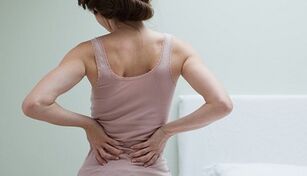
About 80 percent of adults experience back pain, and if you also have problems, know that you are not alone. This can be fixed. The main thing is to understand the origin of pain, but there are many factors. We have collected the leading causes of back pain that can cause back pain. How to relieve illness? There is a way.
Back pain can appear at any age and with physical fitness. So, there is a dull, persistent or periodic pain, and there is a sudden acute attack, after which it is difficult for a person to move. Pain can appear suddenly due to weight lifting, it can develop with increasing age due to changes in the spine or as a result of accidents. An inactive lifestyle is also a major cause of back pain. Especially when the daily routine is not diluted with physical activity (exercise, swimming, fitness, yoga).
In most cases, lower back pain is acute and short-term or less severe, but lasts from a few days to a few weeks. In such cases, a person still does not lose his activity, the ability to move and serve himself in daily life.
Subacute pain is pain that persists after an acute period and lasts for 4 to 12 weeks. If after this period the pain persists, it is called chronic. Sometimes, treatment can help get rid of chronic back pain. But in some cases, the pain persists despite medical treatment and surgery.
Thus, back pain, the cause is often age-related and is related to wear on the joints, discs and spinal cord, or mechanical pain:
1. Keseleo
This can cause severe back pain. Stretching occurs due to turning or lifting something incorrectly. And also due to heavy lifting or stretching. This condition can cause cramps in the back muscles, which also causes pain.
2. Use an intervertebral disc

One of the most common causes of back pain. This manifestation is the loss of disk integrity, cracks appear. On a young, healthy back, the disc allows the bottom to bend, bend, and rotate. But over the years, the elasticity of the disc decreases, and it loses its ability to absorb shock.
3. Hernia
It can appear due to heavy lifting, poor posture, accidents, sports injuries, and so on. There is fluid in the middle of the lumbar disc; for a variety of reasons, it can come out and irritate nearby nerve roots. There is a lot of nerve fiber in the disc wall, and tearing the wall can cause severe pain.
4. Radiculopathy
This condition occurs due to compression, inflammation and / or damage to the roots of the spine. Moreover, stress on the nerve roots causes pain, numbness, or tingling sensations that spread to other parts of the body that are connected to the nerve. The problem can arise if the middle spinal canal narrows or the hernia pinches the nerve root.
5. Sciatica
Compression of the sciatic nerve, which travels through the back and extends to the back of the leg. This compression causes shock or burning pain in the lower back, combined with pain in the back. And even in rare cases, when nerves are squeezed between adjacent discs and bones, a person may feel severe numbness and weakness in the legs. By the way, this condition appears due to a tumor or cyst that presses on the sciatic nerve or its roots.
6. Spinal stenosis
In the case of this disease, in addition to back pain, a person may experience numbness or weakness in the legs while walking. And also with loss of sensitivity.
7. Scoliosis and other skeletal disorders

People usually do not have special problems with curvature of the spine until middle age.
Low back pain is not often associated with serious medical conditions. But you still need to know their whereabouts in order to see a doctor on time. Defeating the diseases listed below is possible only with medical help. This:
1. Infection
This is not a cause of lower back pain, but can affect the vertebrae (osteomyelitis), intervertebral disc (discitis), or sacroiliac joint (sacroiliitis).
2. Tumor
Sometimes tumors appear in the back (and to some degree, of course there will be pain and other symptoms), but often these are metastases that spread as a result of cancer in other parts of the body.
3. Cauda equina syndrome
The disease is sometimes accompanied by a ruptured disc. This is because the disc material is pressed into the spinal canal and compresses the lumbar and sacral nerve root bonds. In connection with this disease, a person may have problems urinating and intestinal.
4. abdominal aortic aneurysm
This occurs when large blood vessels that supply blood to the abdomen, pelvis, and legs become abnormally dilated. Also, lower back pain can be a signal that the aorta has enlarged and there is a risk of rupture.
5. Kidney stones
Stones can cause severe pain in the lower back (usually on one side).
Other factors and causes that can cause lower back pain:
- Inflammatory diseases of the joints.For example, arthritis, spondylitis, inflammation of the vertebrae.
- Osteoporosis. This is a bone disease accompanied by a decrease in bone density and strength, which can lead to fractures of the spine.
- Endometriosis.Female disease that can be accompanied by pain in the pelvis and lower back.
- Fibromyalgia.Pain syndrome, accompanied by muscle aches and fatigue. It is chronic.

What to do with back pain?
First, you need to have a good understanding of the cause of pain. What can help for one disease will not cause (and possibly worsen) another disease. And in some cases, immediate hospitalization is needed. That is why make sure you listen to body signals and, if necessary, see a doctor or take appropriate action.
How to Treat Low Back Pain:
1. You can rest your back after a certain period of time
Many back problems can be solved (or overcome) by avoiding strenuous activity. However, it is not recommended to rest more than a few days, as too long activity does not complicate treatment.
2. Limited activity
This means staying active but avoiding actions and attitudes that increase pain. For example, if sitting for a long time in a car or at a table makes the pain worse, then set a timer to get up every 20 minutes and walk or stretch gently. Minimizing the actions and positions that exacerbate the pain will help prevent or relieve painful cramps and speed up the healing process.
3. Cold / hot therapy
Warm baths, warming pads, body wraps are ideal for stretching tense muscles and increasing blood flow. If your back pain is caused by inflammation, you can try ice or cold compresses to reduce swelling. It is important to protect the skin during the procedure to prevent tissue damage.
4. Pain medication
The most common free medication is an anti-inflammatory drug that relieves back pain caused by swollen nerves or muscles. And in some cases, analgesics can help. Vitamin B, muscle relaxants, various gels and ointments are effective.
5. Physiotherapy
Usually part of the treatment for back pain. Stretching is very helpful: the stronger your muscles, the better your back can move without injury. It is recommended to start small - stretch the muscles of the lower back, buttocks, hips, legs for 20-30 seconds and stop stretching if it hurts.
You also need to strengthen the muscles of the abdomen, thighs, and back that support the spine. Low-impact aerobic exercise improves blood flow and promotes healing of injuries without spinal tremors. For example, you can exercise with a stationary bike and an elliptical trainer, walk and swim.
In fact, every exercise that keeps the heart cycle healthy for a long time is very beneficial for the body. Regular physical activity is important to maintain healthy freedom of movement and healthy spine flexibility.












































